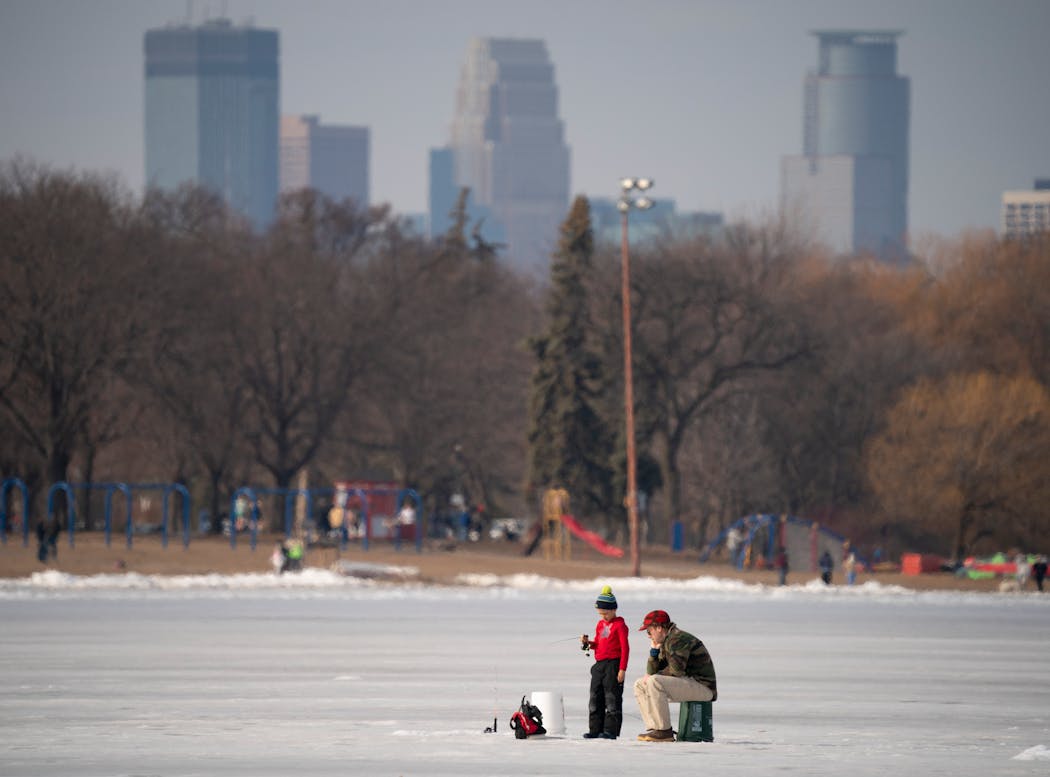How safe is it, really, to walk on Minnesota's iced-over lakes?
Listen and subscribe to our podcast: Via Apple Podcasts | Spotify | Stitcher
One of the defining sights of a Minnesota winter is looking out on a frozen lake and seeing people sitting on stools, fishing rods in their hands. But for some lifelong Minnesota residents, it can still be bewildering to see another person calmly planted in the middle of an icy lake.
After 26 anglers were stranded on a block of Lake Superior ice last month, one reader turned to Curious Minnesota, our community-driven reporting project fueled by questions from readers. He asked: How safe is it, really, to walk on the iced-over lakes in Minneapolis?
Lisa Dugan, the Minnesota Department of Natural Resources recreation safety outreach coordinator, said you are never going to get a straight answer to that question.
"The standard answer is, really, ice is never 100% safe, which is absolutely true because conditions can change so quickly," Dugan said. "It's really knowing the factors that you need to take into consideration to know if the ice that you're on is going to support your weight."
Four inches is the minimum ice thickness for someone to be able to walk across an iced-over lake. That minimum jumps up to 8-12 inches for cars and 12-15 inches for trucks.
Dugan says the best way to check the safety of the ice is to have an ice chisel with you while moving across the ice. Other ways to check the thickness include an auger, drill and a tape measure.
But the minimums do not guarantee safety. When the weather is warmer and the ice is melting, it is not as safe as during a below-freezing day. Snow cover also slows the freezing process, so ice with a thick snow layer on top is less sturdy.
The type of ice also makes a difference. Minnesota state climatologist Luigi Romolo said walking on white ice, which isn't perfectly bonded like black ice, requires doubling the minimum thickness.
"Even if you check the thickness of the ice at one spot with an auger or with a drill, there is no guarantee that the thickness will be the same 100 feet away from that point or even just a few steps from that point," Romolo said. "It's really sketchy so you should always be very careful."
Lake size and depth also matter. Smaller lakes tend to freeze sooner at the start of winter, but they also melt earlier when the season ends.
The DNR keeps track of fatalities and incidents on the ice. Dugan said looking back at those stats for the past decade, most of the fatalities happen at the beginning and end of the season — although not always.
As a result, Dugan said people should remain extra diligent during the bookends of the season. The freeze-thaw cycle begins when the weather warms and deteriorates the ice so that it is half as strong as ice during the depths of winter.
"There's nothing worth risking your life for going out on late-season ice," Dugan said. "There'll be another ice season. There always is."
If you'd like to submit a Curious Minnesota question, fill out the form below:
Read more Curious Minnesota stories:
Why does I-35E through St. Paul have a 45-mph speed limit?
How did Minneapolis end up with a street named after a Persian king?
Why was I-94 built through St. Paul's Rondo neighborhood?
Why are vehicle tabs more expensive in Minnesota than in other states?
Why is Minnesota more liberal than its neighboring states?



